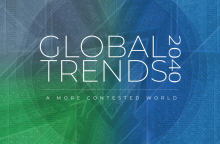
Every four years, the National Intelligence Council, the public-facing arm of the Director of National Intelligence Council and the 16 intelligence agencies under her stewardship, issues its Global Trends report, looking far into the future to determine what threats the United States will need to deal with years hence.
The just-released Global Trends 2040: A More Contested World is the seventh such report issued by the NIC. It differs from previous reports in many ways, most notably in that it addresses the still-evolving changes wrought by the current global pandemic and, while it does talk about traditional warfare, it has a strong focus on social issues. Here is how a report in the New York Times begins:
U.S. intelligence officials warned in a report issued on Thursday about the potential fragmentation of society and the global order, holding out the possibility of a world where international trade is disrupted, groups of countries create online enclaves and civic cohesion is undermined.
The report, compiled every four years by the National Intelligence Council, mixes more traditional national security challenges like the potentially disruptive rise of China with social trends that have clear security implications, like the internet’s tendency to exacerbate political and cultural divisions.
A previous version of the report, released by the Obama administration in 2017, highlighted the risk of a pandemic and the vast economic disruption it could cause — a prescient prediction in hindsight.
The new report said that the coronavirus pandemic showed the weakness of the world order and that the institutions devised to face past crises are inadequate to coordinate a global response to new challenges like the spread of Covid-19. The failure of those institutions deepened public dissatisfaction and further eroded faith in the old order, the report said.
Want more?
Here is a link to the NYT article
And here is a link to the National Intelligence Council Report
Written by George GaldorisiPosted in Blog,This WeekApril 15, 2021
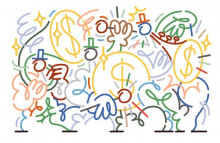
Do you feel confused about the economy and whether we are in a boom or bust? It is likely that you do, as there is vastly more heat than light regarding where the economy is going. Depending on what news media you pick and when you engage, you might see unbridled optimism or impending doom.
That’s why I was drawn to an article entitled: “17 Reasons to Let the Economic Optimism Begin.” While I wasn’t looking for a warm fuzzy or a security blanket, this piece did tease out the reasons that the trend lines (trends – not guarantees) are heading in the right direction. Don’t plan that Paris vacation yet, but lean into living life again. Here is how it begins:
But strange as it may seem in this time of pandemic, I’m starting to get optimistic. It’s an odd feeling, because so many people are suffering — and because for so much of my career, a gloomy outlook has been the correct one.
Predictions are a hard business, of course, and much could go wrong that makes the decades ahead as bad as, or worse than, the recent past. But this optimism is not just about the details of the new pandemic relief legislation or the politics of the moment. Rather, it stems from a diagnosis of three problematic mega-trends, all related.
There is not one reason, however, to think that these negative trends have run their course. There are 17.
Want more? You can read the rest of the piece here
Written by George GaldorisiPosted in Blog,This WeekApril 15, 2021

The BookFest is free to attend. Just go to the website and check out the live stream to watch panels and conversations. Sat. April 17th is dedicated to readers, and Sun. April 18th is dedicated to writers.
Mark Coker, founder of Smashwords; prolific New York Times bestselling author Jonathan Maberry; Patrick M. Oliver founder of Say it Loud!; and skeptic, author and thinker, Michael Shermer, are doing conversations during the two-day online event. These intimate one-on-one talks give attendees the opportunity to learn more about each individual, and to take a deep dive into the topics discussed.
Delivering the opening keynote for The BookFest Spring 2021 is author of the #1 Amazon bestseller The Art of Hybrid Timber Framing, Bert Sarkkinen. As the founder of Arrow Timber, Sarkkinen takes attendees on a journey to find long-term happiness.
Plus, panel discussions include an array of writers, literary professionals, and experts discussing the books we read, relevant topics of our times, the art and craft of writing, and more.
Check out the Live Author Chats and the BookFest Spring Picnic Giveaway on Sat, April 17th.
On Sun, April 18th writers will get a chance to network and ask their burning questions during the Ask the Industry Experts Anything: Live Q&A for Writers of Every Level.
To stay informed on everything BookFest-related, and to get a free Virtual Gift Bag emailed to you after The BookFest Adventure, sign up for email alerts: https://www.thebookfest.com/signup/
www.TheBookFest.com
#TheBookFest #TheBookFestSpring2021
Written by George GaldorisiPosted in Books,Fire and IceMarch 26, 2021
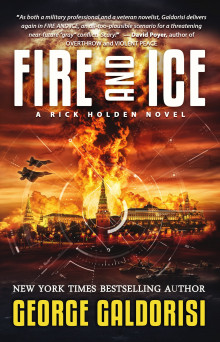
ORDER IT ONLINE NOW
Back of the Book
Long a thorn in Russia’s side, the tiny country of Belarus has become the fulcrum of a geopolitical standoff. When Belarusian vigilantes sabotage pipelines carrying Russian oil, Vladimir Putin seizes upon the attacks as a pretext to invade and occupy the former Soviet Republic. When the West responds weakly to his aggression, an emboldened Putin begins launching devastating and deadly attacks against energy infrastructure across the globe—including North America. With no way to import oil and gas, all of Western Europe has fallen hostage to Putin and his rogue nation.
To meet the challenge, CIA Operative RICK HOLDEN is recalled from his cover as a Navy SEAL and Naval Intelligence Officer LAURA PETERS, newly assigned to an elite cell within DoD’s European Command, is tasked with his oversight. After spending the last several years assigned to commands half a world apart, the highly effective duo is reunited against a backdrop of international intrigue and political brinksmanship.
Their mission: Rescue a captured American from Putin’s henchmen and then race against time to recover stolen nuclear weapons before they can be sold to vengeful terrorists.
Written by George GaldorisiPosted in AI at War,BooksMarch 26, 2021
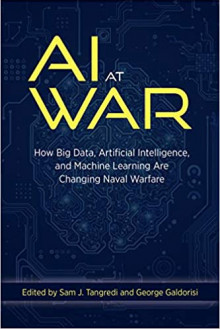
Publication Date: April 15th, 2021
Back of the Book
Artificial intelligence (AI) may be the most beneficial technological development of the twenty-first century, but it is often misunderstood outside of specialists in the field. AI at War provides a balanced and practical understanding of this dawning new technology, explaining the importance of machine learning, human-machine interfaces, and big data analysis, components that are often omitted or misunderstood. While AI has many potential applications, Tangredi and Galdorisi have brought together more than thirty experts to focus on those elements relating to national security, making clear the importance and the potential of AI in defending the nation and in warfighting. Contributors include Robert Work, former Deputy Secretary of Defense; Admiral James Stavridis, former Commander, Supreme Allied Commander Europe; Admiral Michael Rogers, former Director of the National Security Agency; and Admiral Scott Swift, former Commander of the U.S. Pacific Fleet; as well as scientists and operators who share their theoretical and experiential knowledge of this “game-changing” new field.
What People are Saying
“Because AI is going to war with us (in both senses), those interested in the nation’s security must attend to its potentials and perils. There is no better place to start than with this volume, where professionals and academics observe AI’s contribution from more angles than we can imagine.” –Martin C. Libicki, author Cyberspace in Peace and War, distinguished visiting professor, U.S. Naval Academy
“AI at War is an extremely powerful book that should be read by every national security practitioner, every naval commander, and every concerned citizen. Editors Tangredi and Galdorisi have provided some of the brightest minds within government, industry, and academia the opportunity to weave an intellectual tapestry of profound breadth and depth on the myriad questions related to how Artificial Intelligence will shape future warfare. It is an “instant classic” that will do more to generate needed debate on the subject than any book published in recent decades.” –Capt. John E. Jackson, USN (Ret.), E.A. Sperry Chair of Unmanned and Robotic Systems, U.S. Naval War College, editor of One Nation, Under Drones
“Books by techies about data science, artificial intelligence and machine learning put many people to sleep after a page or two. But wait, here is a book on those subjects that is a real page-turner written by a famous spy catcher whose career thwarted the wicked cyber plots of our enemies, and by the dean of naval historians whose books have recounted the great successes of American technology in winning and deterring wars. In clear and crisp prose they illuminate the huge promise in mastering these technologies, and the terrible consequences of failing to do so.” –John Lehman, former secretary of the Navy
“…Should be read by everyone from warfighters to concerned civilians.” –Joseph S. Nye Jr., former dean of Harvard’s Kennedy School of Government and author of Do Morals Matter? Presidents and Foreign Policy from FDR to Trump
Written by George GaldorisiPosted in Blog,Book NewsOctober 15, 2020

Asked the question, “Who is the most powerful person in publishing,” most would not guess correctly, but they would likely assume that it was a man – and they would be wrong. That honor goes to Madeline McIntosh, the U.S. chief executive of Penguin Random House.
I was taken by a recent article describing her accession to this position – at an atypically young age – because it did a deep dive into her career path, while also addressing the important question regarding book sales. The title of the piece, “Best Sellers Sell the Best Because They’re Best Sellers,” sums up the business side of the article.
What surprised me is that her climb was not a straight climb up the corporate ladder, but rather a series of twists and turns, zigzags and lateral moves, many of them quite risky, but all of them invaluable in preparing to lead the biggest of the big-five publishing houses. Indeed, Penguin Random House is larger than the remaining top four publishers combined!
You will find her story fascinating and enriching. Want more? You can read the rest of the piece here
Written by George GaldorisiPosted in Blog,This WeekOctober 12, 2020

The world is flooded – appropriately – with tributes to the late Supreme Court Justice, Ruth Bader Ginsberg. As the second woman appointed to the Supreme Court, Justice Ginsburg’s pointed and powerful dissenting opinions earned her late-life rock stardom.
While there have been many detailed and thoughtful commentaries on her life, I was drawn to one in the New York Times that, for me, captured the essence of what she contributed to the Court and the Nation.
Her late-life rock stardom could not remotely have been predicted in June 1993, when President Bill Clinton nominated the soft-spoken, 60-year-old judge who prized collegiality and whose friendship with conservative colleagues on the federal appeals court where she had served for 13 years left some feminist leaders fretting privately that the president was making a mistake. Mr. Clinton chose her to succeed Justice Byron R. White, an appointee of President John F. Kennedy, who was retiring after 31 years. Her Senate confirmation seven weeks later, by a vote of 96 to 3, ended a drought in Democratic appointments to the Supreme Court that extended back to President Lyndon B. Johnson’s nomination of Thurgood Marshall 26 years earlier.
There was something fitting about that sequence because Ruth Ginsburg was occasionally described as the Thurgood Marshall of the women’s rights movement by those who remembered her days as a litigator and director of the Women’s Rights Project of the American Civil Liberties Union during the 1970s.
Want more? You can read the full article here
Written by George GaldorisiPosted in Blog,Writing TipsOctober 8, 2020

Why would anyone want to write anything today longer than a tweet? Why indeed? And why labor away trying to write for a mainstream audience? Perhaps the best way to capture that is to quote my friend Norman Polmar, who is fond of saying. “History is what the historians and writers say it is.” Norman has published over forty books on naval history and most consider him the authoritative source on the subject. Someone has to write down what happens…and that becomes ground truth.
Here’s another way to look at it, and, I trust, will help you understand that writing stories isn’t some odd thing that only a few people do. In “Book People” John Sutherland put it this way, “Storytelling is as human as breathing. Literature, since it emerged 4,000 years ago, has shaped the lives of most humans on planet Earth. We are what we read.”
One of the best answers to the question, “Why Write?” comes from my friend and co-author, Dick Couch. Here’s how he put it in an article in our alumni magazine some years ago:
For me, I gotta write, and it’s the adventure of it that’s hooked me. As the writer, I can do it all. I get to be the National Security Advisor who recommends the action to the President who must commit the forces. I’m the senior officer who sends his men into action and who feels the pain if they don’t make it back. I’m the enemy and the defender; logistician and staff planner. But most of all, I’m a young man again, that fresh lieutenant who must lead his men into battle.
Some men want to die with their boots on. When I cash in my chips, I want to be slumped over the keyboard. And they can plant me with my word processor. I may wake up and want to write about it.
Finally, we all recognize we live in a highly technical world. But that often makes us turn to data as the king of the hill. It isn’t. Here’s how Michael Lewis put it in, The Undoing Project “No one ever made a decision based on a number. They need a story.”
Want more? Check out my blog for dozens of writing tips
Written by George GaldorisiPosted in Blog,This WeekOctober 5, 2020
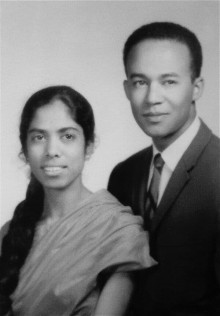
Kamala Harris’s parents, Donald Harris and Shyamala Gopalan grew up under British colonial rule on different sides of the planet. They were each drawn to Berkeley, California and became part of an intellectual circle that shaped the rest of their lives.
In this comprehensive New York Times article, it is easy to see the important forces that shaped Senator Harris’s outlook on life and led to her many successes, culminating in her recent selection as the Democratic Party’s vice-presidential candidate.
Want more? You can read the rest of the piece here.
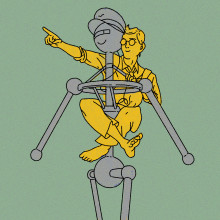
Much ink has been spilled about the future of robots and how they will either help – or hurt – humanity. Some still fear HAL from 2001 A Space Odyssey.
That is why I was drawn to a recent piece, “A Case for Cooperation Between Machines and Humans.” The subtitle is revealing: “A computer scientist argues that the quest for fully automated robots is misguided, perhaps even dangerous. His decades of warnings are gaining more attention.” Here is how it begins:
The Tesla chief Elon Musk and other big-name Silicon Valley executives have long promised a car that can do all the driving without human assistance.
But Ben Shneiderman, a University of Maryland computer scientist who has for decades warned against blindly automating tasks with computers, thinks fully automated cars and the tech industry’s vision for a robotic future is misguided. Even dangerous. Robots should collaborate with humans, he believes, rather than replace them.
Late last year, Dr. Shneiderman embarked on a crusade to convince the artificial intelligence world that it is heading in the wrong direction. In February, he confronted organizers of an industry conference on “Assured Autonomy” in Phoenix, telling them that even the title of their conference was wrong. Instead of trying to create autonomous robots, he said, designers should focus on a new mantra, designing computerized machines that are “reliable, safe and trustworthy.”
There should be the equivalent of a flight data recorder for every robot, Dr. Shneiderman argued.
It is a warning that’s likely to gain more urgency when the world’s economies eventually emerge from the devastation of the coronavirus pandemic and millions who have lost their jobs try to return to work. A growing number of them will find they are competing with or working side by side with machines.
Want more? You can read the full article here











